As the ground begins to soften, it becomes the perfect time to plant a tree. But tree planting is more than just digging a hole in the ground. Improperly planting a tree can cause slowed growth, increased susceptibility to pests, stem girdling roots and premature death. Continue reading “Be sure you are properly planting your trees this spring”
Month: April 2019
Wildfire Report
WILDFIRE REPORT FOR APRIL 4, 2019
Fire season is upon us. Each year an estimated 1,100 wildfires burn in DNR protection areas (about half the state, generally the more forested areas) and another estimated 2,500 wildfires burn in parts of the state where fire departments are the primary responders. Two-thirds of these fires occur in spring. There is a great deal of dry vegetation and fallen leaves and other debris present this time of year, which is quick to dry out. Accompanied by warmer weather, drops in humidity and gusty winds, wildfires can quickly ignite and spread. So far this year,75 fires have occurred, burning 569 acres. Main fire causes have been debris burning and equipment; 25 structures have been threatened by these fires and 2 buildings have been destroyed.
With the nicer weather, homeowners are cleaning up around their properties, sometimes choosing to burn leaves and branch debris. Debris burning is the leading cause of wildfires, especially this time of year. Burning is not your only option. Try alternatives such as composting or leaving brush in the woods for wildlife cover. The best practice is to not burn at all or to wait until surrounding vegetation greens-up in the summer. If you wish to burn, get a burning permit and follow the rules of the day. You can stay aware of fire danger and burning permit requirements by checking our website dnr.wi.gov, keyword “fire” or calling 1-888-WIS-BURN. Information is updated each day at 11 a.m.
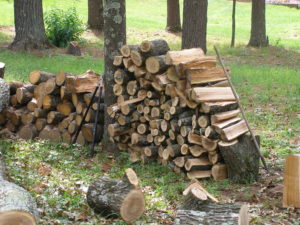
Move firewood at least 30 feet away from your home.
Firewise Tip: If you burn wood for home heating, it’s time to move any remaining firewood stacked near your home to a spot that’s at least 30 feet away. If you dump wood ash outdoors, spread the ash in an area free of vegetation and debris and drown with water to make sure any hidden embers are fully extinguished. Or leave the ash in a metal bucket with a tight- fitting lid until it is completely cool.
Protect oaks from oak wilt by waiting to prune
By Don Kissinger, urban forester, 715-348-5746, don.kissinger@wisconsin.gov and Paul Cigan, forest health specialist, 715-416-4920, paul.cigan@wisconsin.gov
To protect oak trees from the often-fatal oak wilt disease, don’t prune, cut or injure oak trees from April through July.
Pruning and cutting oaks in spring and early summer leaves them vulnerable to oak wilt, which rapidly kills trees in the red oak group and weakens those in the white oak group. Any damage during this time, including broken branches caused by storms, exposes living tree tissue beneath the bark and provides an opportunity for the oak wilt fungus to infect the tree.
Sap-feeding beetles introduce the disease by carrying oak wilt spores from infected trees or firewood to fresh wounds. Healthy oaks can become infected in as little as 15 minutes after the creation of a wound.
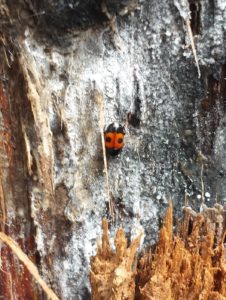
Sap-feeding beetle on diseased oak tree in Sawyer County.
The trees most likely to die from oak wilt infection are in the red oak group, including northern pin oak, northern red oak, red oak and black oak. The white oak group is more likely to survive infection and includes bur oak, swamp white oak, white oak and English oak.
Tree paint or wound dressing is not normally recommended on pruned or wounded surfaces, but for damaged oaks an immediate light application of these products may be the only defense against oak wilt infection from April through July.
Pruning in spring can be damaging to any deciduous tree because their energy reserves are low as they produce new buds and leaves following the winter months. In general, the best time to prune is in winter when trees are dormant.
As of January 31, oak wilt has been found in all Wisconsin counties except Ashland, Iron, Forest, Taylor, Door, Kewaunee, Calumet and Manitowoc counties. Several of these counties contain the highest abundance of healthy and productive oak forests in the state. Taking recommended precautions will help keep them that way for years to come.
Oak wilt and other diseases move easily on or in firewood logs year-round, so keeping firewood local, or purchasing Wisconsin-certified firewood, is another important component of protecting trees and keeping forests healthy. Visit the DNR firewood page for more information and a directory of certified firewood vendors.
More information, including a recently released oak wilt video, is available at the DNR oak wilt page. Additional information about proper pruning techniques is available from community foresters or through DNR resources such as this tree pruning poster.
Treat your valuable ash trees against EAB
By Bill McNee, DNR forest health specialist, Oshkosh, bill.mcnee@wisconsin.gov, 920-360-0942
Spring is the best time to evaluate valuable ash trees and determine if they should be treated to protect them from emerald ash borer (EAB). Emerald ash borer is currently the most damaging threat to trees in the state, killing more than 99 percent of the ash trees it infests.
Insecticide treatments to prevent EAB infestation are usually applied between mid-April and mid-May, so it is important to start planning now. The first thing homeowners should do is check their ash trees for signs of infestation. Woodpecker damage is easy to see this time of year and is often the earliest visible sign of EAB. Photos of other signs and symptoms can be found on the DNR EAB website.
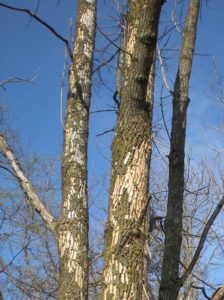
Signs of EAB infestation include woodpecker damage where the birds pick away ash tree bark to feed on larvae.
Emerald ash borer has become so widespread that homeowners should consider treating valuable ash trees no matter where they are in Wisconsin. The highest risk of EAB infestation is within 15 miles of a known infestation, but it is widely believed that there are additional, undetected EAB infestations throughout the state. To see a map of known EAB infestations, visit the Wisconsin EAB website.
While the best time to treat ash trees is before they are infested, treatments of infested trees can still be successful if done while EAB populations within the tree are low or moderate. Some ash trees may be too heavily infested to save or they may have other problems that make them poor candidates for treatment.
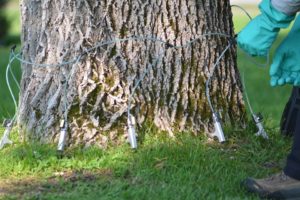
Trunk injection treatment to protect against EAB. Credit: Matthew Karst.
You should consider several factors when deciding whether to treat your ash trees. Insecticide treatments can be costly, but the investment may be worthwhile if you consider the many benefits that healthy yard trees provide, including higher property values, better air quality, shading and cooling for homes and more. Removing and replacing your ash trees is another option and may be the best choice for heavily infested and lower value trees. For trees that you decide are worth saving, however, the cost to treat may still be less than removing and replacing them with other species. This factsheet from UW-Extension can help you decide whether a tree is worth treating.
If you decide to treat, or if you want to discuss treatment options with a professional, call a certified arborist or search online and in phone books for other businesses. Check the credentials and insecticide applicator certification of any business before hiring them to treat your ash trees.
Treatments are not economically practical for ash found in woodlots. Any questions about woodlot management should be directed to a professional forester.
Despite the cold winter temperatures in late January and early February, don’t postpone treatment of ash trees. Weather data and collection of overwintering EAB larvae at two sites in Waukesha County predict high insect survival rates in most of the state. Female beetles can lay up to 200 eggs, so EAB populations will quickly rebound from any mortality that occurred due to cold weather.
More information about EAB and management options can be found through the Wisconsin EAB website.
Prepare for the return of gypsy moths
By Bill McNee, DNR forest health specialist, Oshkosh, bill.mcnee@wisconsin.gov, 920-360-0942
Gypsy moth eggs should start hatching in a few weeks as temperatures continue to warm. Homeowners should survey their trees for egg masses and either treat or remove the eggs now to help protect trees from defoliation and reduce future caterpillar populations.
Property owners should start by looking for the egg masses. They can be found on nearly any outdoor surface, including tree trunks, undersides of branches, buildings, firewood piles and other outdoor objects. They are tan-colored lumps about the size of a nickel or quarter. Each egg mass can contain 500 to 1,000 eggs that will soon hatch into hungry caterpillars. While statewide gypsy moth numbers are currently low, isolated trees and locations may have high populations.
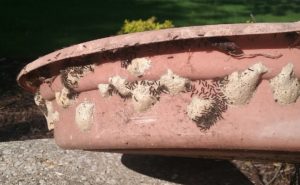
Gypsy moth larvae hatch from egg masses on outdoor bowl.
If egg masses are found, there are two options to help reduce pest numbers. Available at many garden centers and retail stores, horticultural oils that suffocate the eggs can be directly applied to the masses. These are most effective when temperatures are above 40 degrees and a return to freezing is not imminent. Alternatively, egg masses within reach can be scraped into a can of soapy water and left to soak for a few days before being discarded in the trash.
Insecticide treatments may be appropriate for larger trees that have many egg masses. Some types of treatment are done before eggs hatch, and some are done while the caterpillars are small. Property owners looking to hire a business to treat large yard trees this spring should contact them soon. A list of certified arborists is available on the Wisconsin Arborist Association website. Additional businesses offering insecticide treatments may be found online or in a phone book. Questions about woodlot management should be directed to a professional forester.
Additional information about management options for homeowners, including sticky barrier bands and burlap collection bands, is available at the Wisconsin gypsy moth website.
